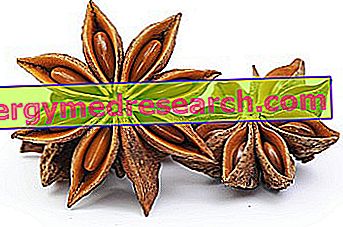
Name: Theobroma cacao
Family: Sterculiacee
Order: Malvaceous
Generality
Cocoa and chocolate are foods currently consumed in most developed countries of the world, while their consumption is very limited in producing countries, all developing countries.

Cocoa and chocolate are real foods, despite the fact that they can be considered - thanks to the substances they contain - "functional products": in fact, there are many health properties attributable to these foods; among these, the one of greatest impact and of most interest in recent years concerns the antioxidant properties linked to the polyphenol content.
Antioxidant and anti-inflammatory
A myriad of varieties of chocolate can be found on the market, intended both from a qualitative and purely packaging point of view: milk, dark chocolate, different percentages of cocoa, or chocolate to drink, cocoa powder, white chocolate, etc.
Fondant Benefits
Among these types, dark chocolate is undoubtedly the one of choice: from a health point of view it represents a real "food-drug", to be taken naturally with moderation, in adequate doses and without exaggerating, getting caught by the "throat" "; one of the qualities highlighted by various clinical trials is the protection provided against cardiovascular diseases, but the influence exerted on the production of anti-inflammatory factors is also important; with the assumption of dark chocolate, the mechanisms leading to the production of pro-inflammatory agents, such as prostaglandins, thromboxanes and leukotrienes, are inhibited.
The antioxidant content is very high: already in 1996 the Lancet published the first research on the properties of antioxidants present in cocoa (antioxidants, as we know, have a recognized usefulness in the fight against free radicals, with consequent reduction of potential risks of many diseases).
More and more importance is being taken on research into compounds of natural origin that can combat free radicals, which are very harmful to health. Free radicals are reactive species of oxygen (ROS) and nitrogen (RNS), with an unpaired electron in the outer orbital; this feature makes them very unstable, with a tendency to react very easily with various types of biomolecules.
Molecular oxygen in living organisms is essential for the performance of various metabolic processes; during all these reactions there is a physiological production of free radicals and reactive intermediates. Under normal conditions, ROS production is necessary for the functioning of biological processes, such as supporting the immune response; for this reason, there is a state of equilibrium between the endogenous production of free radicals and their neutralization by antioxidant defense mechanisms. However, when the ROS escape the control of neutralization systems, their reactive potential generates toxic phenomena.
The main radical species are: superoxide anion (O 2 - ∙), hydroxyl radical (OH), nitric oxide (NO ∙), nitrogen dioxide (NO 2 ∙) and peroxide radical (LOO ∙).
The body, under normal conditions, has the ability to counteract and fight these reactive species through an antioxidant system that includes enzymatic and non-enzymatic mechanisms. Enzymes include superoxide dismutase, catalase and glutathione peroxidase, while non-enzymatic substances include vitamin E, vitamin C, carotenoids, polyphenols and anthocyanins.
Cocoa Polyphenols
The cocoa polyphenols are divided into 3 groups: Catechins, or flavan - 3 - oils (about 37%), anthocyanins (4%) and Proanthocyanidins (58%), consisting of catechins or epicatechins.
The quantity of polyphenols in dark chocolate is far superior to that present in milk chocolate; this can be verified - as well as experimentally in the laboratory - by tasting the food; in fact, the polyphenol content is always associated with a bitter and astringent taste, which can be found regardless of the amount of cocoa present in the product.
Numerous clinical studies have shown the positive effects that flavonoids have in preventing diseases at the cardiovascular system level; in fact, a high intake of flavonoids in the diet (chocolate, especially if it is dark, is rich in it) has proved to be an important aid in reducing the onset of CVD (cardiovascular diseases).
A very important study, illustrated on "Focus on Chocolate", by Ottaviani et al. was performed on an indigenous population of the Island of Kuna: it has been observed that a predominant consumption of cocoa and its derivatives has led, in this population, to a lowering of the incidence of arterial hypertension, practically absent. This data could only have been a coincidence linked perhaps to other factors, genetic and environmental; however, the study was continued also on individuals who for the most disparate reasons moved away from their place of origin: the result was the appearance of cases of hypertension, and a more in-depth analysis showed that changing lifestyle is the diet also changed radically, with the introduction of new foods and the abandonment of the use of cocoa and its derivatives.
From this study, several hypotheses were then made on the flavonoid / cardiovascular benefit bond: the most important of these is the one formulated by Schroeter et al, which indicates epicatechins as mediators able to influence the activity of nitric oxide at vascular level.
Flavonoids would be able to stimulate the production and release of nitric oxide; indeed, to be more precise, they would influence the activity of the enzyme responsible for the synthesis of nitric oxide (NO synthase): in this way a process of vasodilation would be promoted based on the hypotensive effects of flavonoids introduced with the diet.
Also in this review it is shown, through studies carried out on healthy individuals, how a dietary intake of flavonoids purified from cocoa extracts and derivatives, after only two hours from the intake, is able to inhibit the oxidation of LDL.
Polyphenols have also proved to be powerful immunomodulators, able to lower the inflammatory response significantly. To demonstrate this important factor was a study carried out by Dr. Romina Di Giuseppe of the Catholic University of Campobasso, in association with the National Cancer Institute of Milan, published in the Journal of Nutrition ; this research has been one of the largest epidemiological studies conducted in Europe; in fact, it involved 20, 000 people ("Progetto Moli-sani").
The study was conducted because the chronic inflammatory state is able to increase the risk of developing a cardiovascular disease, from heart attack to stroke, so it is very important to be able to control the inflammatory phenomena, and to do this one of the markers more promising and simpler to use is PCR, Protein C Reactive.
The epidemiological study developed by comparing the blood values of this protein, in association with the amount of habitually consumed chocolate: out of 11, 000 people examined, 4, 849 were all in good health and without risk factors; of these, 1, 317 did not consume any type of chocolate, while 824 consumed regularly, but only of the dark type.
The results of the research have proved to be encouraging: in fact, people who habitually eat dark chocolate in moderate quantities have relatively lower Protein C Reactive levels in their blood than others; in this way their risk of inflammation is greatly reduced.
How much chocolate to eat
However, the quantities of chocolate are very important: a moderate consumption of dark chocolate is needed, which is around 6.7 g / day to reduce the inflammatory state by 17%; a small percentage, therefore, sufficient to take advantage of a reduction in the risk of cardiovascular disease equal to 1/3 in women and 1/4 in men.
Continue: Cocoa and chocolate: Natural Antidepressants »



